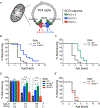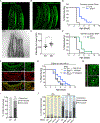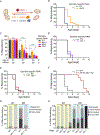Mitochondrial GTP metabolism controls reproductive aging in C. elegans
- PMID: 37708895
- PMCID: PMC10842941
- DOI: 10.1016/j.devcel.2023.08.019
Mitochondrial GTP metabolism controls reproductive aging in C. elegans
Abstract
Healthy mitochondria are critical for reproduction. During aging, both reproductive fitness and mitochondrial homeostasis decline. Mitochondrial metabolism and dynamics are key factors in supporting mitochondrial homeostasis. However, how they are coupled to control reproductive health remains unclear. We report that mitochondrial GTP (mtGTP) metabolism acts through mitochondrial dynamics factors to regulate reproductive aging. We discovered that germline-only inactivation of GTP- but not ATP-specific succinyl-CoA synthetase (SCS) promotes reproductive longevity in Caenorhabditis elegans. We further identified an age-associated increase in mitochondrial clustering surrounding oocyte nuclei, which is attenuated by GTP-specific SCS inactivation. Germline-only induction of mitochondrial fission factors sufficiently promotes mitochondrial dispersion and reproductive longevity. Moreover, we discovered that bacterial inputs affect mtGTP levels and dynamics factors to modulate reproductive aging. These results demonstrate the significance of mtGTP metabolism in regulating oocyte mitochondrial homeostasis and reproductive longevity and identify mitochondrial fission induction as an effective strategy to improve reproductive health.
Keywords: GTP metabolism; bacteria-host interaction; gene-environment interaction; mitochondrial distribution; mitochondrial dynamics; oocyte quality control; reproductive aging; succinyl-CoA synthetase; vitamin B12.
Copyright © 2023 The Authors. Published by Elsevier Inc. All rights reserved.
Conflict of interest statement
Declaration of interests The authors declare no competing interests.
Figures







Update of
-
Mitochondrial GTP Metabolism Regulates Reproductive Aging.bioRxiv [Preprint]. 2023 Apr 3:2023.04.02.535296. doi: 10.1101/2023.04.02.535296. bioRxiv. 2023. Update in: Dev Cell. 2023 Dec 4;58(23):2718-2731.e7. doi: 10.1016/j.devcel.2023.08.019. PMID: 37066227 Free PMC article. Updated. Preprint.
References
Publication types
MeSH terms
Substances
Grants and funding
LinkOut - more resources
Full Text Sources

